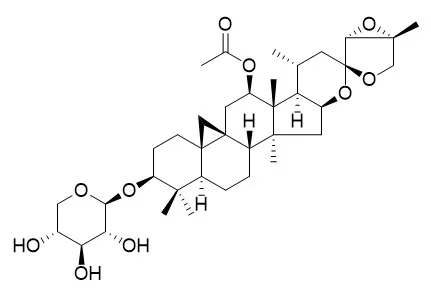| In vitro: |
| Breast Cancer Res Treat. 2004 Feb;83(3):221-31. | | Growth inhibitory activity of extracts and purified components of black cohosh on human breast cancer cells.[Pubmed: 14758092 ] | The purpose of this study was to determine whether black cohosh contains constituents that inhibit the growth of human breast cancer cells, and therefore might eventually be useful in the prevention or treatment of breast cancer.
METHODS AND RESULTS:
Black cohosh rhizomes were extracted with methanol/water and fractionated by solvent-solvent partitioning to yield three fractions: hexane, ethyl acetate and water. The ethyl acetate fraction displayed the highest potency in two cell-based assays, growth inhibition and cell cycle analysis. This fraction inhibited growth of both the ER+ MCF7 and ER-MDA-MB-453 human breast cancer cell lines with IC50 values of about 20 and 10 micro g/ml, respectively. It also induced cell cycle arrest at G1 when tested at 30 micro g/ml and at G2/M at 60 micro g/ml in MCF7 cells. This suggests that the extract contains a mixture of components with the more active (or more abundant) causing G1 arrest and the less active causing G2/M arrest. We then examined specific components in this extract.
The triterpene glycoside fraction obtained by polyamide column chromatography, and the specific triterpene glycosides actein, 23-epi-26-Deoxyactein and cimiracemoside A, inhibited growth of the MCF7 human breast cancer cells and induced cell cycle arrest at G1.
METHODS AND RESULTS:
The most potent compound, actein, decreased the level of cyclin D1, cdk4 and the hyperphosphorylated form of the pRb protein and increased the level of p21cip1 in MCF7 cells, changes that may contribute to the arrest in G1. Further studies are in progress to identify the mechanisms by which actein and related compounds present in black cohosh inhibit growth of human breast cancer cells. | | J Pharm Pharmacol. 2009 Aug;61(8):1089-96. | | Inhibition of inducible nitric oxide synthesis by Cimicifuga racemosa (Actaea racemosa, black cohosh) extracts in LPS-stimulated RAW 264.7 macrophages.[Pubmed: 19703353 ] | Cimicifuga racemosa (Actaea racemosa, black cohosh) is used as an anti-inflammatory, antipyretic and analgesic remedy in traditional medicines. The present study focuses on the effects of C. racemosa root extracts on inducible nitric oxide synthase (iNOS) in lipopolysaccharide-stimulated murine macrophages (RAW 264.7).
METHODS AND RESULTS:
C. racemosa rhizome and phosphate-buffered saline extracts were analysed for phenolcarboxylic acids and triterpene glycosides using an HPLC photodiode array/evaporative light-scattering detector system. iNOS was characterised by measurement of iNOS protein (immunoblotting), iNOS mRNA (semiquantitative competitive RT-PCR), nitric oxide production (nitrite levels) and nuclear translocation of nuclear factor-kappaB (p65 subunit) protein. Incubation of lipopolysaccharide-stimulated macrophages with aqueous C. racemosa extracts (0-6 mg/ml) inhibited nitrite accumulation in a concentration-dependent manner. C. racemosa extracts also reduced iNOS protein expression and iNOS mRNA levels in a dose-dependent manner. C. racemosa extracts did not significantly inhibit iNOS activity and did not affect nuclear translocation of nuclear factor-kappaB (p65 subunit) protein. Incubation with the extract was associated with a concentration-dependent reduction of interferon beta and interferon regulatory factor 1 mRNA. Among the triterpene glycosides, 23-epi-26-Deoxyactein was identified as an active principle in C. racemosa extracts.
CONCLUSIONS:
Extracts from the roots of C. racemosa inhibit nitric oxide production by reducing iNOS expression without affecting activity of the enzyme. This might contribute to the anti-inflammatory activities of C. racemosa. |
|






 Cell. 2018 Jan 11;172(1-2):249-261.e12. doi: 10.1016/j.cell.2017.12.019.IF=36.216(2019)
Cell. 2018 Jan 11;172(1-2):249-261.e12. doi: 10.1016/j.cell.2017.12.019.IF=36.216(2019) Cell Metab. 2020 Mar 3;31(3):534-548.e5. doi: 10.1016/j.cmet.2020.01.002.IF=22.415(2019)
Cell Metab. 2020 Mar 3;31(3):534-548.e5. doi: 10.1016/j.cmet.2020.01.002.IF=22.415(2019) Mol Cell. 2017 Nov 16;68(4):673-685.e6. doi: 10.1016/j.molcel.2017.10.022.IF=14.548(2019)
Mol Cell. 2017 Nov 16;68(4):673-685.e6. doi: 10.1016/j.molcel.2017.10.022.IF=14.548(2019)